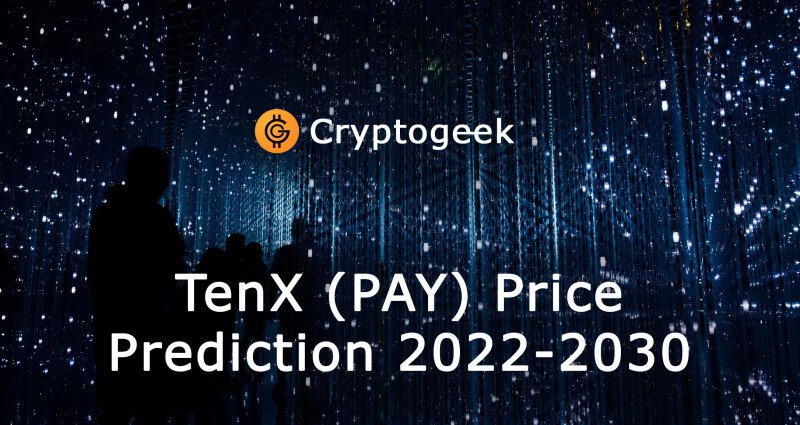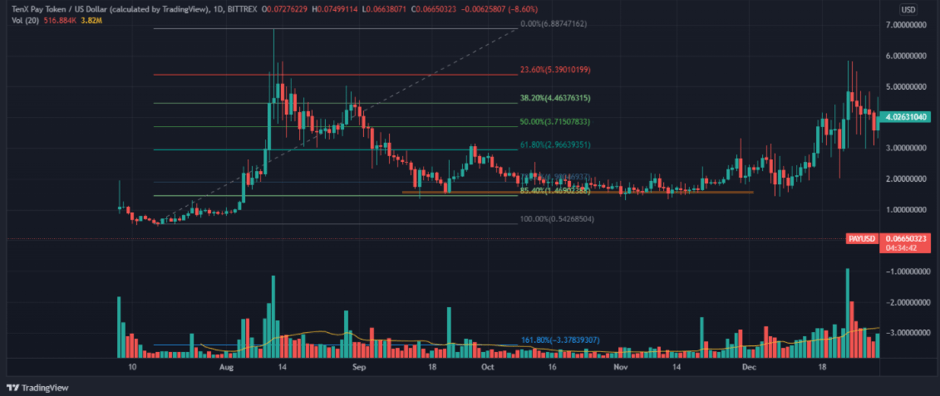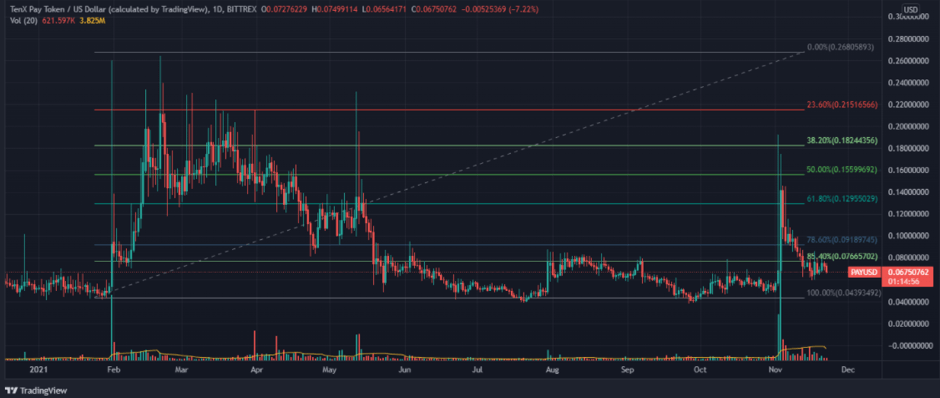TenX (PAY) Price Prediction 2022-2030. Should You Buy It Now?


The goal of TenX is to allow a widespread adoption of programmable money - aka cryptos.
But will it be able to reach its goal even in spite of its transition to Mimo?
In this article we want to give you a deep analysis of the characteristics of PAY, and to provide you with price predictions from 2022 to 2030 - of course, this article is not financial advice - always do your own research before investing your money!
The future of this crypto may surprise traders and investors: PAY’s transition to decentralized finance may attract more people, even because it will be related to one of the few stable tokens pegged to the Euro - PAR.
What Is Tenx (PAY)?
The first whitepaper of TenX was released in 2017, and the supplemental whitepaper in 2018.
Even if the main purpose of this cryptocurrency is always the same, the project experienced some major changes, and it is very useful to know them if you want to understand the value of this crypto.
But let’s start from the beginning.
The company behind PAY, the TenX Pte. Ltd, was founded in 2015 by Toby Hoenisch and Paul Kittiwongsunthorn. Then, Michael Sperk joined the founding group.
The company has its headquarters in Singapore.
As we mentioned, the main goal of this crypto is the widespread adoption of digital currencies - or, to better say it, programmable money.
The creators are in fact pretty confident that the future of money is crypto, because it is the only form of money that allows people to fully control their financial destinies.
Nevertheless, they knew that the transition couldn’t be too dramatic. For this reason, the ecosystem behind PAY works like a sort of bridge that connects the old money to the new one: the TenX Card is an example of what the founding team wants to reach in terms of adoption.
Backed by Visa, the card allows people to spend supported cryptos “at over 42 million points of acceptance globally” (TenX Whitepaper).
At this point a clarification is needed: even if the ticker of TenX is PAY, in reality we should make a distinction between the two:
- TenX is the brand;
- PAY is the utility token created by the company: it is an ERC-20 built on Ethereum, and has a total supply of 205,218,256 tokens.
There is also a reward token, TENX - another ERC-20 - whose function is to make people accumulate daily rewards.
As we said, the main purpose of the creators is always the same, but they wanted this transition to DeFi to fully respect their goal - to allow people to control their financial destinies with no central authority.
And that’s why in April 2021 TenX became Mimo.
The team is almost the same - as the company announced in an official blog post - since the rebranding operation was made possible thanks to the experience accumulated in the crypto space thanks to TenX.
Mimo is a DeFi platform that works on Ethereum and focuses on providing people with a safe way to earn with a stablecoin pegged to the Euro - PAR.
All eligible holders are able to exchange their PAYs for MIMOs, so it still makes sense to analyze the price of PAY during the past years, and to watch it in a future perspective - even if the value of MIMO could be even higher than our predictions thanks to its DeFi nature.
Tenx (PAY) Price Analysis Of The Past Years
When PAY was launched, its value reached over $45.
2017
During the first half of 2017, the price of TenX (PAY) was extremely volatile.
In July 2017, and precisely on July 7th, PAY opened at USD 73.06, but closed at USD 1.10.
From that moment on, the price of PAY remained stable, more or less.
The following peak arrived on August 12th 2017, when the price reached around $4.6.
In a few days, the price experienced a downtrend that led the price to a swing low at $1.59 - at the 85.4% Fibonacci retracement level.
After a dead cat bounce - a short recovery of the price - it reached the 61.8% Fibonacci level. Soon after, the price got back to the support level at around $1.55.
PAY closed 2017 with another peak at around $4.8.

2018
The year began with a downtrend that lasted around six months and led the price of PAY below the 100% Fibonacci retracement level - at around $0.48.
This price is very important for the historical analysis of TenX, because it represents a very strong support level for the cryptocurrency.
Despite the very short-term recoveries experienced by the price, the price remained mainly around the support level for the rest of the year.

2019
During this year the price of PAY was not so volatile, but the point that needs to be highlighted is that the previous support level became the resistance level.
During the whole year the price moved in a range between $0.1 and $0.47.

2020
During the whole 2020, the price of PAY moved in a range between $0.019 and $0.14.
In fact, despite the volatility of volume that often exceeded the 20-day volume moving average, the price remained quite stable during 2020.

2021
At the beginning of 2021 the price of PAY recovered to double its value: in February 2021 the price reached a peak at $0.21.
After the peak, the price began a downward movement that led the price to $0.041. Also here we find a resistance level: after a short-term recovery, the price reached the same price level at the end of September.
The price of PAY recovered once again in November to reach $0.14 at the beginning of the month, before falling once again.

As we said at the beginning of this article, it is still useful to make price predictions about PAY to better understand the possible future value of MIMO.
| The price as of February 2022 | $0.03633639 |
| Market cap as of February 2022 | $4,289,023 |
| Rank as of February 2022 | #1555 |
| All-time high | $5.22 (August, 2017) |
| Decline (compared to all-time high) | 99.3% |
| All-time low | $0.01703792 (March 13, 2020) |
| Growth (compared to all-time low) | 113.3% |
| Popular markets | Gate.io, OKX, Bittrex, Huobi Global, HitBTC |
To make these predictions we’re considering data, technical and fundamental analysis and experts’ opinions.
Tenx (PAY) Price Prediction 2022
During 2022 the price of PAY should not experience high volatility, staying at around $0.049.
Tenx (PAY) Price Prediction 2023
This year should see a little rise: during 2023 the price should reach around $0.075.
Tenx (PAY) Price Prediction 2025
By 2025 PAY should double its value: the price should reach a level around $0.16.
Tenx (PAY) Price Prediction 2027
Also this year should see a rise if compared to the level that the price of PAY should reach in 2025.
The average price of PAY during 2027 should be $0.32.
Tenx (PAY) Price Prediction 2030
In 2030 the price should overcome once again 1 US dollar, to reach an average price level at around $1.2.
| Year | Min Price | Average Price | Max Price |
| 2022 | $0.047 | $0.049 | $0.055 |
| 2023 | $0.071 | $0.073 | $0.081 |
| 2024 | $0.09 | $0.095 | $0.11 |
| 2025 | $0.15 | $0.16 | $0.19 |
| 2026 | $0.2 | $0.22 | $0.28 |
| 2027 | $0.29 | $0.32 | $0.38 |
| 2028 | $0.41 | $0.44 | $0.53 |
| 2029 | $0.62 | $0.64 | $0.79 |
| 2030 | $0.95 | $0.99 | $1.2 |
Conclusions
With this article we wanted to provide you with useful information about TenX (PAY).
As we told you, TenX is experiencing a rebranding, and even if the PAY tokens will be progressively deprecated, it is still useful to understand the characteristics of PAY and the possible movements of its price: in fact, we have data and we can evaluate the value of PAY, but we don’t have enough data about Mimo and PAR.
Of course, our forecasts don’t want to be financial advice - every trader and investor should always do an independent research before investing money - but the analysis is still useful to try to understand where the project is expected to go.
Nevertheless, the different nature of Mimo and PAR may result in a totally different outcome.
But technical and fundamental analysis - as the ones we can do with the data available for TenX (PAY) - are useful to provide a sort of guideline.







Here are no comments yet. Be the first!